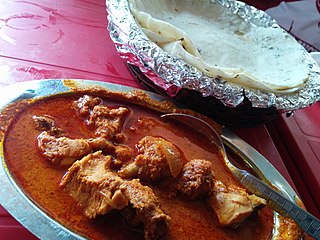
Garam masala [from Hindustani گرم مصالحہ/गरम मसाला ] is a blend of ground spices originating from India. It is common in Indian, Pakistani, Nepalese, Bangladeshi, Sri Lankan and Caribbean cuisines. It is used alone or with other seasonings.

Indian cuisine consists of a variety of regional and traditional cuisines native to India. Given the diversity in soil, climate, culture, ethnic groups, and occupations, these cuisines vary substantially and use locally available spices, herbs, vegetables, and fruits.

Pakistani cuisine can be characterized by a blend of various regional cooking traditions from South Asia, Central and Western Asia, as well as elements from its Mughal legacy. The country's various cuisines are derived from its ethnic and cultural diversity.

Rogan josh also spelled roghan josh or roghan ghosht, is an aromatic curried meat dish originating from Kashmir.

Pilaf or pilau is a rice dish, or in some regions, a wheat dish, whose recipe usually involves cooking in stock or broth, adding spices, and other ingredients such as vegetables or meat, and employing some technique for achieving cooked grains that do not adhere to each other.

Biryani is a mixed rice dish originating among the Muslims of the Indian subcontinent. It is made with Indian spices, rice, and usually some type of meat or in some cases without any meat, and sometimes, in addition, eggs and potatoes.

Tamil cuisine is a culinary style originating in the southern Indian state of Tamil Nadu and other countries of South Asia like Sri Lanka. Both vegetarian cuisine and non-vegetarian cuisine are popular among the Tamil people and have been since ancient times. Meats, along with rice, legumes, and lentils, are also popular. Dairy products and tamarind are used to provide sour flavors. On special occasions, traditional Tamil dishes are served in a traditional manner, using banana leaves in place of utensils. After eating, the banana leaves are then used as a secondary food for cattle. A typical breakfast meal consists of idli or dosa with chutney. Lunch includes Rice, sambar, curd, kuzhambu, and rasam.

Pasanda, also called Parche, is a popular meat Shahi Mughalayi dish from the Indian subcontinent, notably North India, Rampur, Hyderabadi and Pakistani, derived from a meal served in the court of the Mughal emperors. The word is a variation on the Hindi-Urdu word "pasande" meaning "favourite", which refers to the prime cuts of meat traditionally used in the dish.

Cuisine of the Indian subcontinent includes the cuisines from the Indian subcontinent comprising the traditional cuisines from Bangladesh, Bhutan, India, the Maldives, Nepal, Pakistan and Sri Lanka.

Shami kabab or shaami kabab is a local variety of kebab, originating from the Indian subcontinent. It a popular dish in modern-day Indian, Pakistani and Bangladeshi cuisines. It is composed of a small patty of minced meat, generally beef, but occasionally lamb or mutton, with ground chickpeas, egg to hold it together, and spices. Shami kebab is eaten as a snack or an appetizer, and is served to guests especially in the regions of Dhaka, Deccan, Punjab, Kashmir, Uttar Pradesh and Sindh.

Chicken curry is a dish originating from the Indian subcontinent. It is common in the Indian subcontinent, Southeast Asia, Great Britain, Caribbean, and Japan. A typical curry from the Indian subcontinent consists of chicken stewed in an onion- and tomato-based sauce, flavoured with ginger, garlic, tomato puree, chilli peppers and a variety of spices, often including turmeric, cumin, coriander, cinnamon, and cardamom. Outside of South Asia, chicken curry is often made with a pre-made spice mixture known as curry powder.

Kuwaiti cuisine is a fusion of Arabian, Iranian, and Mesopotamian cuisines. Kuwaiti cuisine is part of the Eastern Arabian cuisine. A prominent dish in Kuwaiti cuisine is machboos, a rice-based dish usually prepared with basmati rice seasoned with spices, and chicken or mutton.

Mughlai cuisine consists of dishes developed in the medieval Indo-Persian cultural centres of the Mughal Empire. It represents a combination of cuisine of the Indian subcontinent with the cooking styles and recipes of Central Asian and Islamic cuisine. Mughlai cuisine is strongly influenced by the Turkic cuisine of Central Asia, the region where the early Mughal emperors originally hailed from, and it has in turn strongly influenced the regional cuisines of Northern India, Pakistan and Bangladesh.

Omani cuisine is part of the Khaleeji cuisine and is influenced by Arab, Pakistani cuisine, Iranian, Indian, Asian, Eastern Mediterranean, and African cuisine, reflecting Oman's position as a vast trading empire at the intersection of traditional spice trade routes. Dishes are often based on chicken, fish, and lamb, as well as the staple of rice. Most Omani dishes tend to contain a rich mixture of spices, herbs, and marinades. Omani cuisine differs from other cuisines in the Arabian peninsula, as it is less spicy and seldom served warm.

Telugu cuisine is a cuisine of South India native to the Telugu people from the states of Andhra, Telangana, and Yanam. Generally known for its tangy, hot, and spicy taste, the cuisine is as diverse as the people and regions in which it is consumed.

Aloo gosht is a meat curry, and is a popular dish in North Indian, Pakistani, and Bangladeshi cuisine. It consists of potatoes (aloo) cooked with meat (gosht), usually lamb or mutton or beef, in a stew-like shorba gravy. It may be considered a curry, stew, or shorba depending on the way the dish is prepared, the types of spices used and what country or particular region it was made in. The dish can be served and eaten with plain rice or with bread such as roti, paratha or naan.

The Thalassery cuisine refers to the distinct cuisine from Thalassery town of northern Kerala, which has blended in Arabian, Persian, Indian and European styles of cooking as a result of its long history as a maritime trading post.

Qatari cuisine is made up of traditional Arab cuisine. Machbūs, a meal consisting of rice, meat, and vegetables, is the national dish in Qatar, typically made with either lamb or chicken and slow-cooked to give it a depth of flavour. Seafood and dates are staple food items in the country. Many of these dishes are also used in other countries in the region, because they share many commonalities. In other parts of the region some of the dishes have different names or use slightly different ingredients. One proponent of the importance of Qatar's culinary heritage is chef Noor Al Mazroei, who adapts traditional recipes to include vegan and gluten-free alternatives.

Sai bhaji is a Sindhi vegetarian curry, consisting of dal (lentils), palak (spinach) and other vegetables. It forms a staple part of the local cuisine and is considered a rich source of nutrition due to its mix of various greens.

Acehnese cuisine is the cuisine of the Acehnese people of Aceh in Sumatra, Indonesia. This cuisine is popular and widely known in Indonesia. Arab, Persian, and Indian traders influenced food in Aceh although flavours have substantially changed their original forms. The spices combined in Acehnese cuisine are commonly found in Indian and Arab cuisine, such as ginger, pepper, coriander, cumin, cloves, cinnamon, cardamom, and fennel. A variety of Acehnese food is cooked with curry or coconut milk, which is generally combined with meat such as buffalo, beef, goat meat, lamb, mutton, fish, or chicken.


















